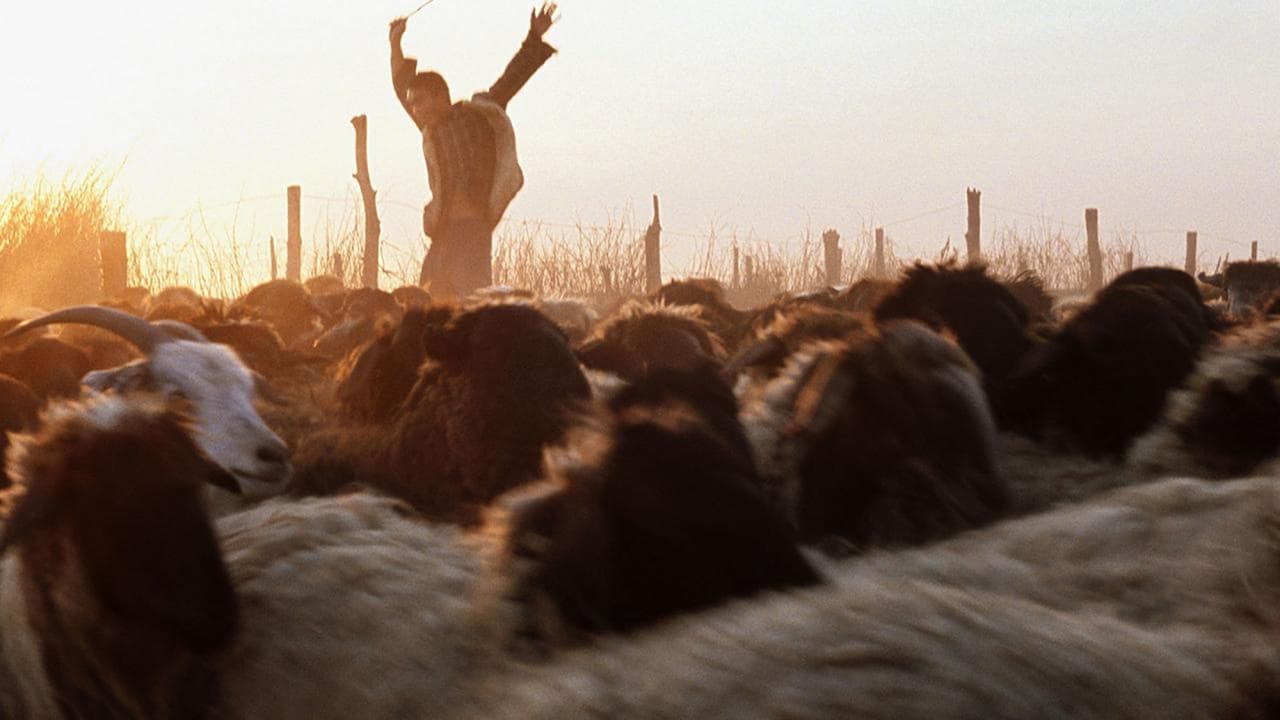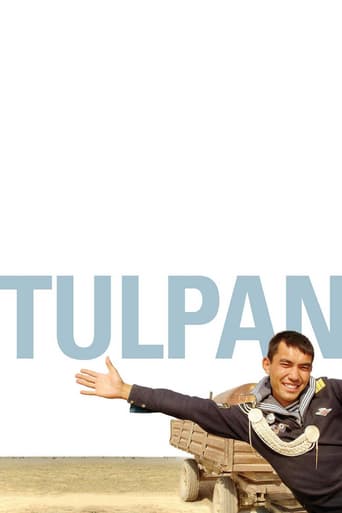



That was an excellent one.
Perfect cast and a good story
Overrated and overhyped
good film but with many flaws
...........................................................from Pasto,Colombia...Via: L.A. CA., CALI, COLOMBIA....and ORLANDO, FL *** This review may contain spoilers ***If you don't know what TULPAN means in English, you will after watching the film. And yet, they never translate it for you...You have to figure it out for yourself! Sometimes, unfortunately, it seems that particular talent is fast becoming a lost art among U.S. movie-goers. Take a film like TULPAN, which is so simple, so unpretentious, and yet, manages to show us things in life that are so delicate and complicated! ***May Contain a Minor Spoiler or Two!*** What motivated me to give TULPAN a look? Certainly not the IMDb Blurb, it really misses the mark! No, my decision was based on a truly accurate, quality review. Originality is something to be prized and praised in a movie. You know how rare it is to encounter a film with something totally original to offer. TULPAN has at least 5 elements that I don't recall seeing in any other cinematic work! Without them, 6 or 7* more than likely would have been my rating...But I'll add 1/2* for each original element, bringing my rating up to 9*. So, What are these elements? 1) ALL the actors in TULPAN appear using their REAL names! Maybe you're thinking you've seen a few other films like that. Well, in ALL the others I remember like this, the production values are horrific and the acting worse. Here the acting is so natural, so oblivious to the camera, it lends a "Slice of life" feel to the production.2) Have seen movies in dozens of different languages! Kazak is not one of them. So, TULPAN is my first in this language related to Turkish.3)Have you ever seen mouth-to-mouth respiration administered to a newborn calf in a movie? Not just once, but several times by two different actors! Elements 4) and 5)....? Let's keep the last two elements a surprise. (Although my alternate title above should give you a hint.) Sheep-herding on the Asian Steppe is anything but exciting. TULPAN REALLY drives that point home. If you're not willing to sit through movies where the pacing is, at times, excruciatingly deliberate, but that reward you in the end for your patience...This is not for you. If you like windows into new and exotic cultures, check TULPAN out! 9* STARS*.....ENJOY/DISFRUTELA! Any comments, questions or observations, in English or Español, are most welcome!
View MoreI had no idea what to expect from "Tulpan". I can't recall where in my movie trolling I'd decided to rent and watch it. Would it be one of those small, eccentric films with a quirky character in the lead? Those can work but I've been a little leery of them lately. The writer/director, Sergei Dvortsevoy, who is 47, is from Kazakhstan where Tulpan is set and has been involved in a half dozen films as writer and director. But I enjoy Russian cinema and Kazakhstan was once part of the Soviet Union so maybe Kazakhstan is the world's largest landlocked country although it does border on the Caspian and Aral Seas. The steppe where the film takes place is the largest dry steppe region in the world and the film offers dramatic vistas of this flat, flat plain where people have lived as nomadic herders for centuries and continue to raise sheep, goats, camels in one of the least densely populated regions on earth.Asa, the main character, has come home from his duties as a sailor in the navy. He hopes to arrange a marriage for himself with the help of his sister and brother-in-law with a local girl he's never met, Tulpan. There is much delicious dry humor in this set up. Asa hopes to set himself up as nomad, living his life in his yurt, scratching out an existence from the hard-scrabble land. The film beautifully portrays for us in almost documentary fashion the life Asa hopes to achieve.His sister's family is lovingly presented. His sister is beautiful and loves her daughter whose constant singing irritates the stern, hard working father, and her young son who gallops about pretending the stick he is straddling is like the horse his father rides. But the authenticity of the life presented here is documentary like and I mean that in the best possible way. The young boy appears to not to be aware of the camera at all as do all of the actors, camels included. So what we see seems a very authentic look at a fragile way of life.And therein lies another of the beauties of "Tulpan". As the attempt at arranging the marriage runs into roadblock after roadblock, we see how much Asa loves that existence. His brother-in-law wonders why Asa would choose such a difficult existence, given the choice. But Dvortsevoy, while showing the daily life and death struggles a herdsman must endure, is also able to demonstrate why someone would do whatever to live a rich life in such a beautiful yet primitive place.I can't recommend "Tulpan" highly enough. See it if you can. I have a feeling what has been captured here will not be around for much longer.
View MoreI watched Tulpan for the second time last night. It seems to me the movie is really about how different people react to wrenching changes, mostly by nursing a fantasy of some sort. Among other things Tulpan documents the _current_ way people and sheep use that steppe, which under the surface isn't very nice.As the "yurt" is a touchstone with the past, it's commonly retained even though it doesn't actually make much sense any more. These herdsmen move very infrequently (if at all), and these yurts are typically surrounded by outbuildings that look pretty permanent. What good really is a moving house if you don't move? The person who insists Asa must be married before getting any sheep is "Comrade Boss" (not brother-in-law Ondas - Asa and Ondas have their differences, but the assignment of sheep is not among them). Ondas and his family cannot move without approval from the Boss. The Boss controls the only veterinarian and most of the vehicles. The Boss tells Ondas he's responsible for every stillborn lamb. All this adds up to the current economic pattern in that area: herds of sheep belong to non-resident owners, who "contract" their care to the actual herdsmen. The herdsmen live sort of like their ancestors, but don't actually own most of the sheep, seldom move, and don't have all that much freedom.Daughter Beke (and also to some extent her mother and Asa's sister Samal) appear to cope with the dichotomy between the idealized life and the actual life of a herdsman's family by rather defiantly singing lots of folk songs. Perhaps the folk songs are just the most visible sign of fantasizing the old ways.Tractor driver Boni survives the dichotomy by diving deeply into a fantasy pastiche of music, sex, and wealth. He's the conduit to the "outside", and so is more worldly than the herdsmen he serves. But by more objective standards he's woefully uninformed too. At one point he speaks of bypassing the city and going directly to Sakhalin Island. Never mind that Sakhalin Island is in a different country thousands of miles away through several other countries.Asa appears to survive the dichotomy by remaining completely unaware of it. He admires a solar panel in a magazine, without ever realizing no herdsman could possibly afford such a thing. He admires a motorcycle in the magazine too, but without ever reflecting such a thing would be useless without a reasonably accessible supply of gasoline. He compliments Tulpan on wanting to go to college at the same time he wants her to marry him, without any sense that it might be difficult to do both. The scene he draws on his collar is of an idealized herdsman with healthy children (not the half-crazy kids he actually lives with), his own herd of sheep, more wealth than any real herdsman ever had, and the freedom to move wherever he wishes whenever he wishes.Brother-in-law Ondas clings to the old ways even though they don't quite add up any more. He invests a lot of time and effort in quixotic visits to Tulpan's yurt that are doomed from the start. He doesn't know his "neighbors". Although they politely receive him, they apparently weren't ever expecting a marriage proposal visit and don't know quite how to deal with one. Ondas's gift looks like an electric light fixture -with lots and lots of little pieces to keep clean- intended for an elegant room. It wouldn't be of any use in a yurt with dust (and a little smoke?) and no electricity. And he talks of giving a large number of sheep too, never mind that the sheep don't seem to be his to give, or that talking of a large number of sheep in the context of marriage seems irrelevant. The scenic views of far away horizons and sparse vegetation portray what I'd call a semi-desert. Just try to imagine a "tulip" sprouting up between those tufts. If you can imagine it at all, it will look horribly out of place. Likewise the tulip Asa draws into the scene on his collar is in a different style and colors than the rest. It's added on, but not integrated.
View MoreKazakhstan is one of those dusty Central Asian countries left over from the break-up of the Soviet Empire and probably best known in the West as the putative birthplace of Sasha Baron Cohen's media clown Borat. In this film the documentary filmmaker Sergei Dvortsevoy goes some distance toward giving us westerners a taste of real life amongst shepherds on the steppe. Fresh out of the Russian navy submarine service, Asi goes to stay with his sister Samal and her sheep herdsman husband Ondas. Despite the isolation, wind, dust and extreme temperatures, Asi dreams of having his own flock and settling down. But Ondas refuses to help him with the flock until he finds a wife, for a single man cannot be a herdsman. The film opens with Ondas negotiating to marry Asi off to Tulpan, the daughter of a neighbour, but Tulpan, who remains behind a curtain and is never actually seen, rejects him – "His ears are too big". Asi tries again, alas to no avail.This plot is really secondary to an account of what it is like to live and work in a place like this. Ondas's lambs keep dying and the vet is called (how is a mystery). He diagnoses lack of feed, so the family must pack up its Yurt and move elsewhere. Much comedy is provided by a young injured camel being transported in the vet's sidecar, followed by the camel's mother which bites anyone who gets too close. Ondas and Samal's three children also provide plenty of entertainment. The oldest girl sings a mournful folksong all the time, the older boy recites entire news bulletins learned from the portable radio he keeps with him, and the younger boy is just plain cute. Asi's tractor driver friend, with his collection of pin-ups in his cab, also provides some amusement.Life on the steppe is tough, but brings with it a certain amount of freedom. Modernity, in the form of the official news bulletins, parodies of the official style, is at a good distance away. The sheep flocks are big enough to provide a living as long as there is a demand for their wool. Ondas, a proud tough man, would not be happy living in a town. Samal might, though. Dvortsevoy does not idealise his characters and they are all the more appealing. However, I can't see the steppes becoming a tourist destination except for some very hardy travellers.
View More